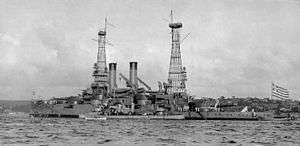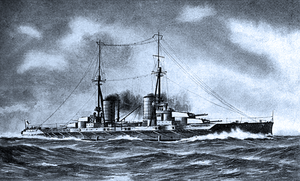List of battleships of Greece
In the early 20th century, the Greek Navy embarked on an expansion program to counter a strengthening of Greece's traditional rival, the Ottoman Empire.[Note 1] The Ottomans ordered a new dreadnought battleship, Reşadiye; in response, Greece ordered the dreadnought Salamis from a German shipyard. The Ottomans acquired the ex-Brazilian Rio de Janeiro and renamed her Sultân Osmân-ı Evvel. Greece responded with a second battleship ordered in France, Vasilefs Konstantinos, built to the same design as the French Bretagne class. As the Ottomans had a significant head start in battleship construction, the Greek Navy purchased two obsolete American pre-dreadnoughts—USS Mississippi and Idaho—as a stop-gap measure in June 1914. The ships were renamed Kilkis and Lemnos, respectively.

Greek naval plans were interrupted by the outbreak of World War I in August 1914, however. Work halted on Vasilefs Konstantinos in August and on Salamis in December 1914. As a result, Kilkis and Lemnos were the only battleships delivered to Greece. Greece remained neutral for the first three years of World War I, though in October 1916, France seized the Greek Navy and disarmed both of the battleships. They remained inactive for the rest of the war. Both ships saw service in 1919–1922 during the Greco–Turkish War. They continued to serve with the fleet until the early 1930s, when they were reduced to secondary roles. Lemnos became a barracks ship while Kilkis became a training ship. During the German invasion of Greece in April 1941, both ships were attacked and sunk in Salamis by Ju 87 Stuka dive-bombers. The two old battleships were scrapped after the end of the war.[Note 2]
Key
| Armament | The number and type of the primary armament |
|---|---|
| Armor | The maximum thickness of the armored belt |
| Displacement | Ship displacement at full combat load |
| Propulsion | Number of shafts, type of propulsion system, and top speed/horsepower generated |
| Service | The dates work began and finished on the ship and its ultimate fate |
| Laid down | The date the keel began to be assembled |
| Commissioned | The date the ship was commissioned |
Salamis

Starting in 1911, the Ottoman Empire—Greece's traditional naval rival—set about modernizing its fleet. That year, the Ottomans ordered the dreadnought Reşadiye. The expansion of Ottoman naval power threatened Greek control of the Aegean; to counter the Ottoman dreadnought, Greece decided to order a dreadnought of its own, Salamis, from a German shipyard.[2] The keel was laid down on 23 July 1913; the hull was complete and ready for launching by 11 November 1914. However, the outbreak of World War I in August 1914 interrupted her completion; work stopped on 31 December 1914. The guns that had been ordered for the ship in the United States were instead sold by the manufacturer, Bethlehem Steel, to the Royal Navy to arm the British Abercrombie-class monitors. After the end of the war, the Greek Navy refused to accept the incomplete hull. She was eventually scrapped in 1932 following a lengthy arbitration between the Greek Navy and the German shipyard.[3][4]
| Ship | Armament | Armor | Displacement | Propulsion | Service | ||
|---|---|---|---|---|---|---|---|
| Laid down | Commissioned | Fate | |||||
| Salamis | 8 × 14 in (360 mm) guns[3] | 9.875 in (250.8 mm)[3] | 19,500 long tons (19,800 t)[3] | 3 shafts, 3 steam turbines, 23 kn (43 km/h; 26 mph)[3] | 23 July 1913[3] | — | Work halted 31 December 1914, broken up in 1932[3] |
Vasilefs Konstantinos
Following the Ottoman purchase of a second dreadnought in December 1913, Sultân Osmân-ı Evvel, a previously Brazilian ship still under construction,[5] the Greek Navy responded with an order for a second dreadnought of its own. The new battleship was to be named Vasilefs Konstantinos and was to be built to the same design as the French Bretagne class from AC de St Nazaire Penhoet. Work began in June 1914 but ceased on the outbreak of war in August and never resumed. The Greek Navy refused the incomplete ship after the end of the war, leading to a contract dispute, which was settled in 1925. The unfinished ship was subsequently broken up for scrap.[3]
| Ship | Armament | Armor | Displacement | Propulsion | Service | ||
|---|---|---|---|---|---|---|---|
| Laid down | Commissioned | Fate | |||||
| Vasilefs Konstantinos | 10 × 34 cm (13.4 in) guns[6] | 11 in (280 mm)[6] | 25,000 long tons (25,000 t)[6] | 4 shafts, 4 steam turbines, 20 kn (37 km/h; 23 mph)[6] | 12 June 1914[3] | — | Work halted August 1914, broken up in 1925[3] |
Kilkis class

Kilkis and Lemnos were built by the US Navy between 1904 and 1908, originally named Mississippi and Idaho. They served with the US fleet until June 1914, when they were purchased by the Greek Navy as a stop-gap measure. They were needed to counter Ottoman naval expansion while the Greeks waited on their newly ordered dreadnoughts to be completed abroad.[7] The two ships reached Greece in July 1914, just before the outbreak of World War I at the end of the month. As Greece remained neutral during the first three years of the war, the two ships saw little service. In October 1916, the French seized the Greek fleet and disarmed Kilkis and Lemnos; they were put back into service at the end of the war. Both ships saw service during the Greco–Turkish War in 1919–1922,[8] with Lemnos also participating in the Allied intervention in the Russian Civil War.[9]
Both ships continued to see service in the Greek fleet until the early 1930s, with Kilkis serving as the flagship of the fleet.[10] In 1932, Lemnos was disarmed and used as a barracks ship, and Kilkis was reduced to a training ship.[3] Lemnos was used as a barracks ship after 1937,[11] and Kilkis became a floating battery at Salamis Naval Base in 1940.[3] During the German invasion of Greece in April 1941, both ships were attacked and sunk in Salamis. German Ju 87 Stuka dive-bombers bombed both ships in the harbor; Kilkis was sunk outright while Lemnos was beached to avoid sinking.[9][12] Both ships were broken up after the end of the war.[13]
| Ship | Armament | Armor | Displacement | Propulsion | Service | ||
|---|---|---|---|---|---|---|---|
| Laid down | Commissioned | Fate | |||||
| Kilkis | 4 × 12 inch guns[14] | 9 in (230 mm)[14] | 14,465 long tons (14,697 t)[14] | 2 shafts, triple expansion engines, 17 kn (31 km/h; 20 mph)[14] | 12 May 1904[14] | 22 July 1914[14] | Sunk by German bombers, 23 April 1941[3] |
| Lemnos | 12 May 1904[14] | 22 July 1914[14] | Sunk by German bombers, 23 April 1941[3] | ||||
See also
Footnotes
Notes
- The Greek Navy had previously built a series of ironclad capital ships, including Vasilissa Olga and Vasilefs Georgios, both built in the late 1860s, and the three Hydra-class ships, built in the late 1880s and early 1890s.[1]
- The museum ship Georgios Averof is sometimes mistakenly referred to as a battleship, but it is actually an armored cruiser.
Citations
- Gardiner, p. 387
- Sondhaus, p. 220
- Gardiner & Gray, p. 384
- Gardiner & Gray, p. 43
- Hough, p. 75
- Gardiner & Gray, p. 198
- Gardiner & Gray, p. 383
- Gardiner & Gray, pp. 383–384
- "Idaho". Naval History & Heritage Command. 28 September 2007. Retrieved 6 December 2011.
- Lautenschläger, p. 64
- Gardiner & Chesneau, p. 404
- Lautenschläger, p. 65
- Hore, p. 89
- Gardiner, p. 144
References
- Gardiner, Robert, ed. (1979). Conway's All the World's Fighting Ships 1860–1905. Greenwich: Conway Maritime Press. ISBN 0-8317-0302-4.
- Gardiner, Robert & Gray, Randal, eds. (1985). Conway's All the World's Fighting Ships, 1906–1921. Annapolis: Naval Institute Press. ISBN 0-87021-907-3.
- Gardiner, Robert & Chesneau, Roger, eds. (1980). Conway's All the World's Fighting Ships, 1922–1946. Annapolis: Naval Institute Press. ISBN 0-87021-913-8.
- Hore, Peter (2006). Battleships of World War I. London: Southwater Books. ISBN 978-1-84476-377-1.
- Hough, Richard (1967). The Great Dreadnought: The Strange Story of H.M.S. Agincourt: The Mightiest Battleship of World War I. New York: Harper & Row. OCLC 914101.
- Lautenschläger, Karl (1973). "USS Mississippi (BB-23) Greek Kilkis". Warship Profile 39. Windsor: Profile Publications. pp. 49–72. OCLC 33084563.
- Sondhaus, Lawrence (2001). Naval Warfare, 1815–1914. London: Routledge. ISBN 978-0-415-21478-0.